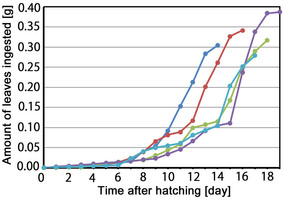Research Abstract
摂取した放射性物質がヤマトシジミに与える生物学的影響
The biological impacts of ingested radioactive materials on the pale grass blue butterfly
2014年5月15日 Scientific Reports 4 : 4946 doi: 10.1038/srep04946

福島第一原子力発電所の事故では、大量の放射性物質が環境中に放出されたが、その生物学的影響はほとんど調査されていない。今回我々は、ヤマトシジミ(Zizeeria maha)を用いて、放射性セシウム摂取線量と死亡率および異常率との関係を定量的に評価した。日本国内で最も汚染度が低い地域と考えられる沖縄の幼虫に、汚染地域で採集した食草を与えたところ、セシウム摂取線量に対応して死亡率および異常率が低線量域で急激に上昇した。この線量反応関係は、べき関数モデルに最も適合し、そこから示される半致死線量および半異常線量は、幼虫1個体当たりそれぞれ1.9および0.76 Bqとなり、体重1 kg当たりではそれぞれ54,000および22,000 Bqに相当した。幼虫期を通じて摂取した線量に対する蛹内の放射性セシウム残留率、および食物内の放射活性濃度に対する蛹内の放射性セシウム蓄積率は、いずれもセシウム摂取レベルが最も低い場合に最も高くなった。我々は、汚染された食物を摂取するリスクについて、少なくともヤマトシジミにとっては現実のものであり、汚染地域に生息するいくらかの他種生物にも当てはまる可能性があると結論付けた。
野原 千代1, 檜山 充樹1, 平良 渉1, 棚原 朗2 & 大瀧 丈二1
- 琉球大学 理学部 海洋自然科学科 分子生理学研究室
- 琉球大学 機器分析支援センター
A massive amount of radioactive materials has been released into the environment by the Fukushima Dai-ichi Nuclear Power Plant accident, but its biological impacts have rarely been examined. Here, we have quantitatively evaluated the relationship between the dose of ingested radioactive cesium and mortality and abnormality rates using the pale grass blue butterfly, Zizeeria maha. When larvae from Okinawa, which is likely the least polluted locality in Japan, were fed leaves collected from polluted localities, mortality and abnormality rates increased sharply at low doses in response to the ingested cesium dose. This dose-response relationship was best fitted by power function models, which indicated that the half lethal and abnormal doses were 1.9 and 0.76 Bq per larva, corresponding to 54,000 and 22,000 Bq per kilogram body weight, respectively. Both the retention of radioactive cesium in a pupa relative to the ingested dose throughout the larval stage and the accumulation of radioactive cesium in a pupa relative to the activity concentration in a diet were highest at the lowest level of cesium ingested. We conclude that the risk of ingesting a polluted diet is realistic, at least for this butterfly, and likely for certain other organisms living in the polluted area.

